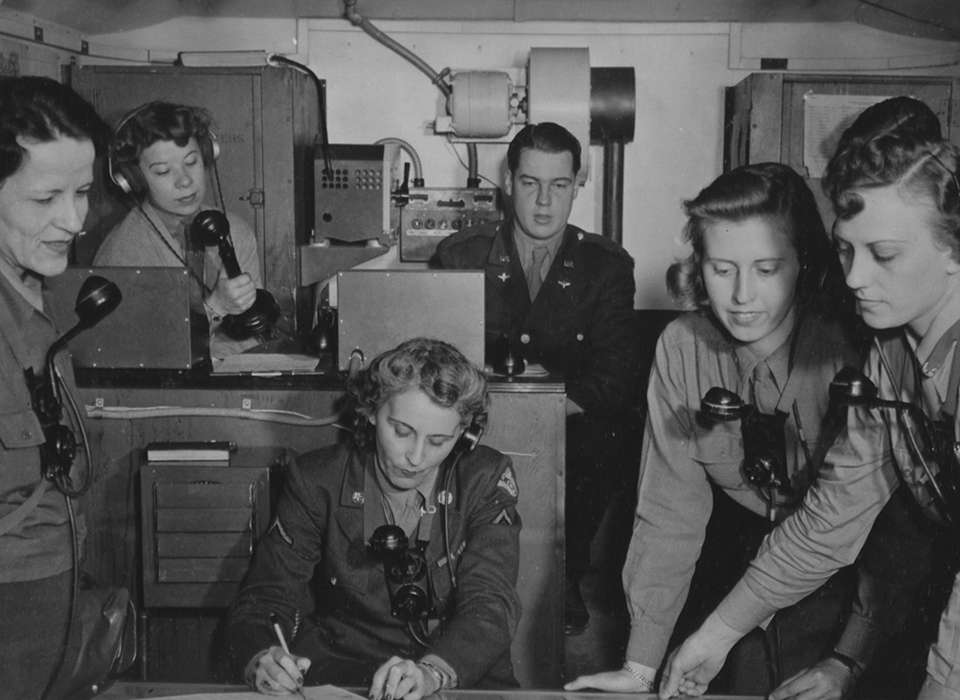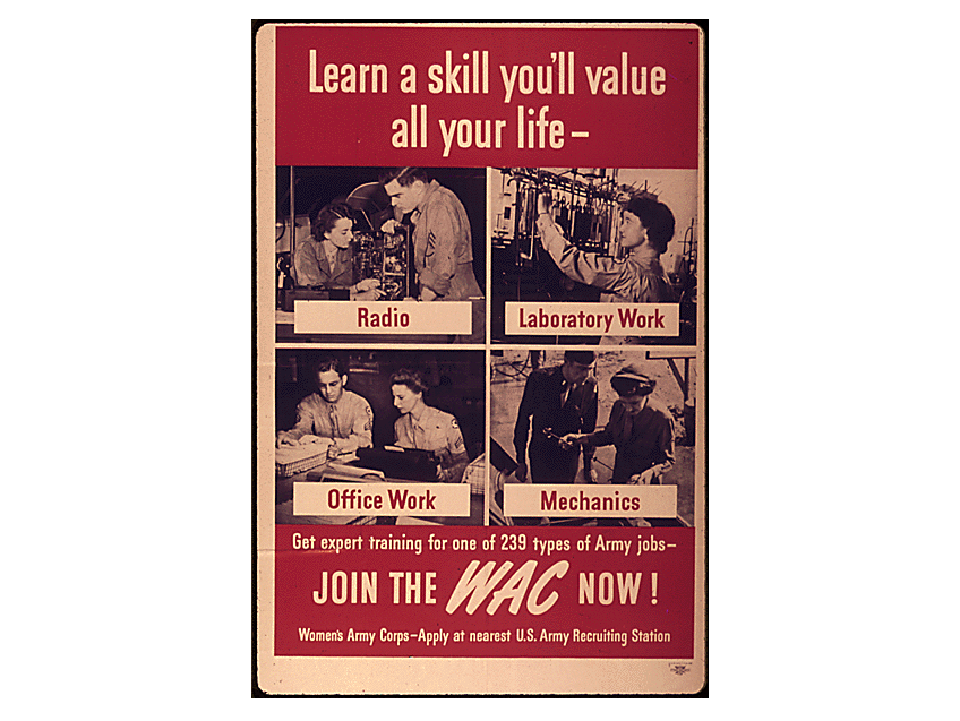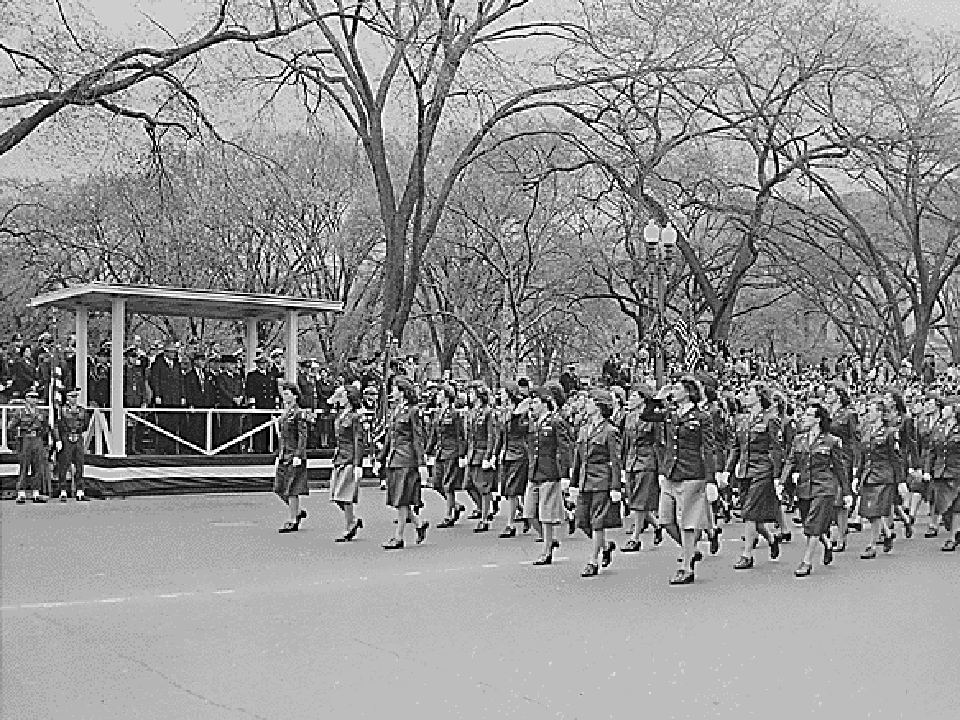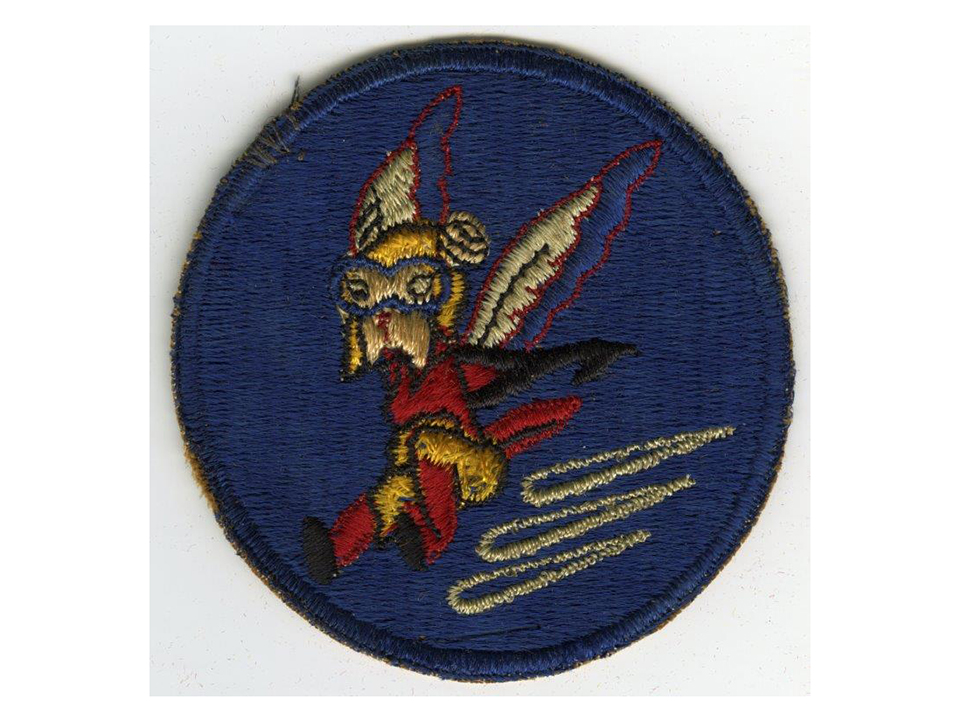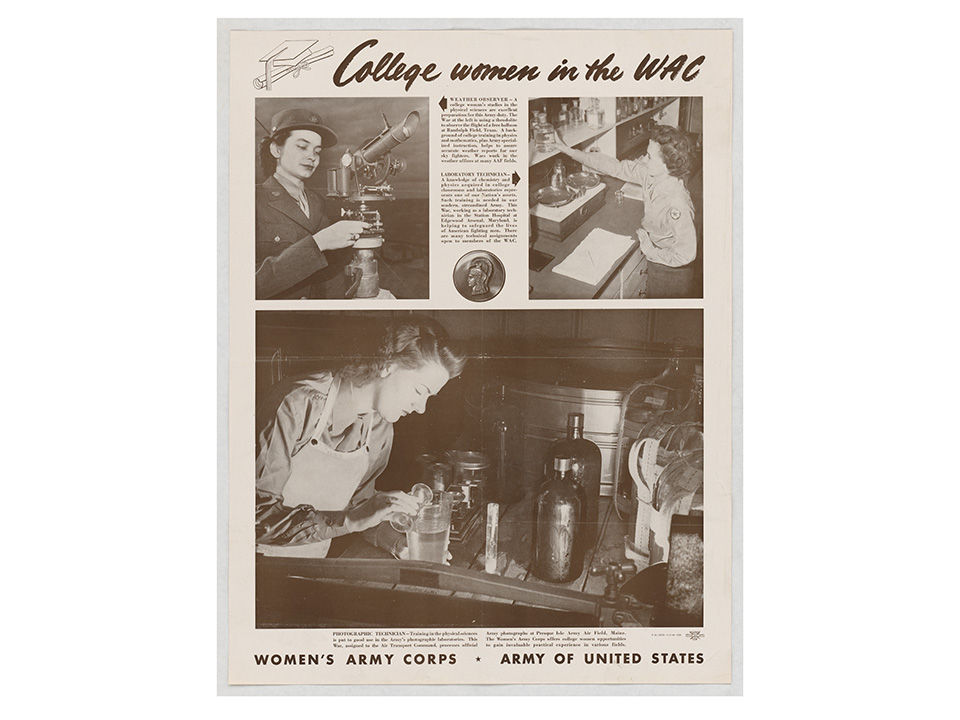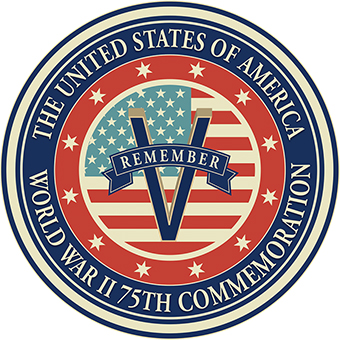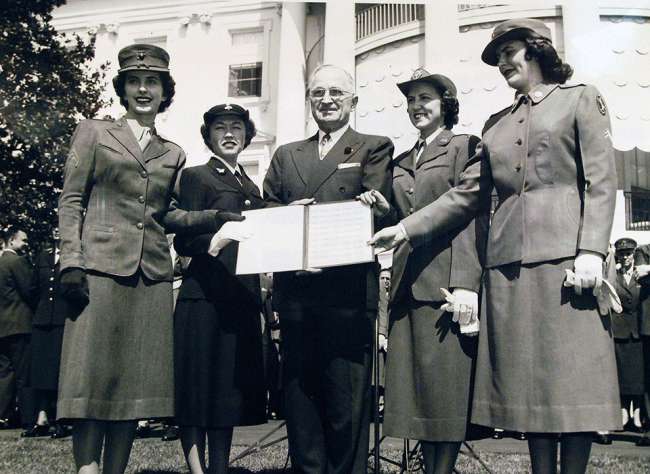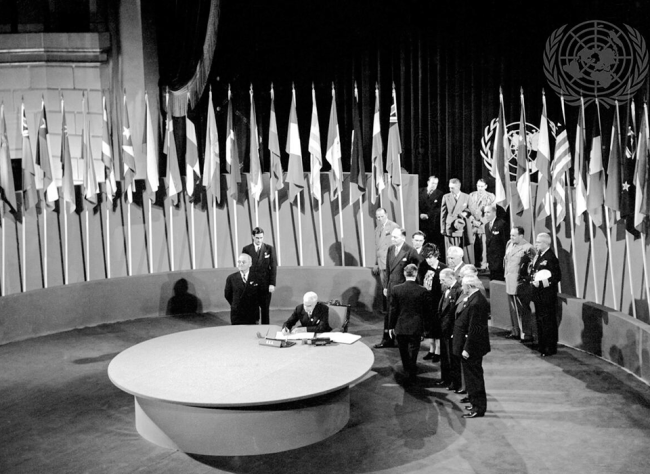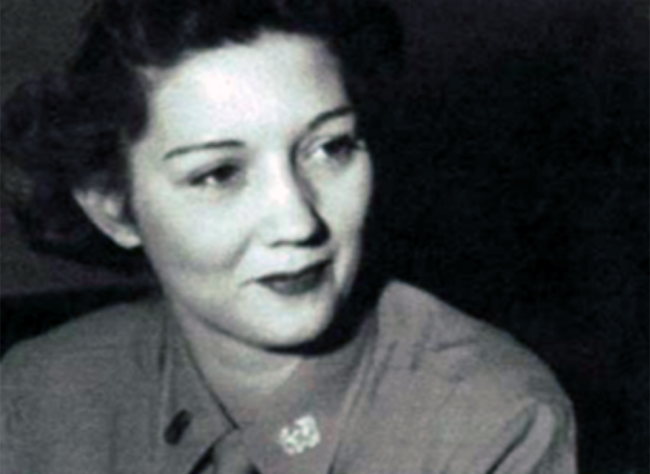Top Image: In England, WACs worked with the Army Air Forces. The WACs pictured here are giving new directions to bomber crews whose aircraft were damaged or had lost their bearings returning from a mission over Germany. USAAF photo from The National Archives.
In May 1946, the Women’s Army Corps (WAC) celebrated its fourth anniversary with parades and parties. As part of the festivities, General Dwight D. Eisenhower gave a speech expressing his appreciation for the corps’ work during the war and congratulated the women still serving as well as those already demobilized and returned home. An article on the occasion in The New York Times added that the Army was asking for former members of the WAC to rejoin the service to help with the post-war occupation work. Despite the demobilization efforts for both male and female servicemembers, the Armed Forces continued to emphasize the importance of women’s participation with the military.
By the end of World War II, the US military had been utilizing women’s participation for several years. Congress established the Women’s Army Corps (WAC) in early 1942, initially as the Women’s Army Auxiliary Corps (WAAC). Other branches quickly followed, with the Navy’s WAVES (Women Accepted for Volunteer Emergency Service), the Marine Corps’ Women’s Reserve (MCWR), the Coast Guard’s SPARS—“Semper Paratus—Always Ready,” and a program for women pilots called the WASP (Women’s Airforce Service Pilots). The requirements and duties of each group varied, but their main goals were the same: using women in non-combat roles in order to free more men for combat duty.
Many of the jobs available to women were similar to the work they performed as civilians. They did clerical, administrative, and communications work, which included switchboard operation, codebreaking, stenography, and more. As women successfully completed the initial work offered to them, the corps offered extended training for more technical and traditionally masculine positions. Most of the corps eventually employed women as drivers and mechanics in the motor pools, electricians, laboratory technicians, ordnance engineers, and more. Members of the WAC could also serve overseas. The WASP program meanwhile employed women pilots to ferry planes across the country, tow targets for artillery practice, deliver cargo, and do other aviation work. By the end of the war, the various corps employed almost 400,000 women in a wide variety of non-combat jobs.
As illustrated in this recruiting poster, there were more than 230 jobs available to women in the WAC, and many learned new skills they could put to use after the war. Office of War Information poster from The National Archives.
Each corps faced many of the same problems in establishment, recruitment, and public relations. One of the early issues was receiving public and Congressional approval for utilizing women in a traditionally masculine sphere. Much of the pushback revolved around questions of women’s ability to successfully complete “men’s work” and fears of whether their femininity would be irreparably damaged because of their service. One way the corps addressed these issues was by emphasizing the temporary nature of the corps. The changes might be unpalatable for the public, but the media tried to assure them that it would only last the duration of the war.
The Women’s Army Corps was originally established as an auxiliary corps as part of this strategy, although administrative problems led to the corps later being absorbed into the army. The WAVES acronym also implied the temporary nature of the corps—the “Women Accepted for Volunteer Emergency Service”—they were volunteers for an emergency situation. While these strategies did help with public relations, by the end of the war there was some pressure for the military to follow through with their promise.
Demobilization
Despite the public’s early hesitation on accepting women into military work, the War Department did not immediately disband all of the corps in the final days of the war. Many in the military expressed a desire to establish permanent women’s corps or incorporate the groups into the regular armed forces, even during demobilization. A study on the utilization of the WAC in the European theater of operations conducted by the General Board of the War Department in 1945 recommended that the Army continued to employ women in non-combat positions through peacetime and in any future conflicts. The report further suggested that the military should eliminate the separate “mission” of the women’s corps and better absorb the women’s units into the military.
Overall, the General Board reported that not only were the women’s corps successful as a whole, but it also argued that women could be utilized overseas during wartime. The report further claimed that “the War Department’s decision to discontinue shipments of WAC personnel to the European Theater and cease furnishing replacements for those redeployed was a serious blow to the European Theater.” However, despite the extensive military support of expanding the corps in the post-war period, demobilization of the women’s corps grew as more men were released home.
Initially, the military ended recruitment for the women’s corps as the first step to disbanding them. The theory was that normal attrition would take care of most of the demobilization. In the last days of the war, releasing most of the women’s corps relied on the same point systems as the male soldiers. As demobilization efforts increased, the military released veterans’ wives, those over the age of 38, and later all married women if they wished to leave. While a tentative date for full WAC demobilization was set for June 1946, both the Army and Navy looked into the possibility of keeping members of the women’s corps longer, since many of the skills common among the women were significantly needed. As a result, demobilization for the women in the Army, Marine Corps, and Navy slowed down again. Only the SPARS met the June 1946 disbandment date, in part because the Coast Guard would return to the authority of the Department of the Treasury during peacetime.
While the Armed Forces were not authorized to accept new enlistments unless they established a permanent corps, they worked to encourage former members to reenlist and current members to remain. The Army offered 15-day furloughs to WACs who volunteered for the post-war program. Additionally, the Navy and Army both drafted legislation to create a reserve and regular women’s corps, respectively. General Eisenhower reached out to various field commanders to gain support for the new WAC, just like General George C. Marshall had done in initially establishing the corps. Lt. Colonel Anna Walker Wilson, the WAC Staff Director in the European theater, told former WACs to take a message back to their communities:
“We are the medium through which the knowledge and experience gained in the utilization of womanpower during this war can be preserved. We are also a nucleus, a framework, around which total utilization of womanpower can be effected in the next emergency.”
Lt. Colonel Anna Walker Wilson
Wilson and others knew that women played a vital role in World War II and wanted to continue that contribution into the future. Many in the military supported the creation of a peacetime women’s corps and vocally expressed their appreciation of the women they served with during the war. In the meantime, the corps continued to demobilize even as the Armed Forces called for women to stay in the service longer or to re-enlist.
What About the WASP?
Unlike the WAC, MCWR, and WAVES, the WASP did not receive offers for reenlistment or a permanent corps. Earlier in March 1944, legislation to militarize the WASP was introduced in Congress but was defeated in June. After the failure of the WASP bill, the program was disbanded in December 1944. Opponents of the WASP argued that the program cost too much and that the women would be taking piloting jobs from male veterans. A week after the last class graduated from the program, the WASP was no more. Unlike the other corps, the women were never officially part of the military, so they were ineligible for many of the benefits the other women enjoyed, like insurance, burial and death benefits, and the opportunities provided by the GI Bill. Some of the bases helped the women return home, but others were left to find their own transportation.
Many of the women wanted to continue flying after being released from the WASP and looked for civilian flying work. Former WASPs were allowed to join the WAC but were not allowed to pilot planes. Many of them stayed in contact with each other and in August 1946, while the other corps drafted legislation for reserve and regular military status, the former members of the WASP met for their first reunion under the Order of Fifinella (named after their gremlin mascot) in Lock Haven, Pennsylvania. The group continued to organize meetings until 2009.
Adjusting to Civilian Life
Like male veterans, members of the women’s corps had mixed reactions to demobilization. Many women enjoyed their time in the service and the new opportunities available to them. This was especially true for the WASPs, many of whom struggled to find their place in the post-war world. Some were able to continue flying after the war, but many industries like commercial airlines turned women pilots away. For other former women’s corps members, however, the end of the war brought them a sense of relief at returning to their old lives. They, like many male servicemen, believed that they sufficiently performed their wartime duty and wanted to go back to normal. Additionally, women had no guarantee that they could return to their pre-war jobs, so many wanted a head start to apply for work and housing before full demobilization created too much competition.
As the United States navigated how to help war veterans, former women’s corps members faced many of the same problems. Newspaper articles about the plight of women veterans focused on how many women struggled with finding new and meaningful jobs, maintaining relationships from before the war, and adjusting to civilian life. After serving in new and exciting jobs in exotic locations, some women found that regular civilian jobs were not satisfying enough. Additionally, women veterans felt abandoned by the general public. Many of the community services offered to male veterans often forgot about the women who served.
In their family lives, many women returned to family and friends who did not approve of their enlistment and wanted them to return to the normalcy of cooking and cleaning. Jokes and vicious rumors about the women’s corps continued to follow the women into their civilian lives. In some cases, women avoided mentioning their time in the service for fear of judgement. Many women reported that serving in the Armed Forces changed their personality and character through gaining confidence, organizational skills, and responsibility. These changes could either help or hinder their previous relationships with parents, friends, and significant others.
This recruiting poster encouraged college educated women to join the WAC, where they could gain practical experiences in their field of study. Office of War Information poster from The National Archives.
In response to the demand for assistance, several groups like the Committee on Services to Women Veterans formed to help the women navigate the post-war world and access some of the resources they needed. The special committee worked with veterans’ centers to assist women in various ways, mainly through career counseling. Other women used their benefits from the GI Bill to start or continue their college educations. In addition to earning bachelor’s degrees, many women used their GI Bill benefits for extended higher education. Betty Bandel, who served as the Director of the Army Air Force WAC, used her benefits to earn her PhD at Columbia, and Charity Adams Earley, the commander of the 6888th Central Postal Directory Battalion, went on to earn a master’s degree at the Ohio State University.
Public reactions to the women’s army corps varied greatly. Many former servicewomen reported facing discrimination for their work with the military. Some companies were unwilling to hire them, and many civilian women’s groups turned them away. At the same time however, many military officials vocally offered their support of the women’s work during the war. Several newspapers also published articles in appreciation of the women’s wartime service and favoring legislation for a peacetime women’s corps. Despite the early public criticism of establishing women’s military corps, the women’s work proved their value and earned them additional support from more media sources.
Beyond 1946
Like their service during the war, the early post-war experiences of women in the military represent a period of change and contradictions. While many wanted to return to civilian life, a large number of women and military officials wanted to expand the opportunities for women’s service with the Armed Forces. The transition period of 1946 marked an important milestone in women’s military participation. Post-war legislation led to the future of women’s military involvement and more non-traditional military roles for women. The proposed bill to establish a more permanent women’s corps finally made headway and was introduced in Congress in April 1947 and later passed unanimously in the Senate.
Further delays, however, delayed the bill until June 1948, when the Women’s Armed Services Integration Act was established. Many eligible former WACs, Marines, and WAVES immediately enlisted in the new version of the corps. The Act allowed for women to serve in the Regular Armed Forces, although still in non-combat roles and as separate units. Future legislation would later fully integrate women into the military and open up more roles, including combat. These changes came in part from women’s service in World War II and the 1946 efforts to keep that contribution alive.
Meet the Author
Brittany Huner is a current PhD student at the University of North Texas. She earned her BA from the University of Northern Colorado and her MA from the University of Colorado at Denver. Her current research examines issues surrounding women and the military during World War II. She focuses on questions of utilization of the corps, recruiting, and public relations. Other research interests include women’s military history involving other conflicts and women in medieval Europe. She is a member of the Society for Military History, Phi Alpha Theta, and a Student Fellow at UNT’s Military History Center. Brittany has presented her work at several conferences, most notably SMH and the University of Alabama’s Conference on Power and Struggle and has published her work in various sources.
This article is part of a series commemorating the 75th anniversary of the end of World War II made possible by the Department of Defense.
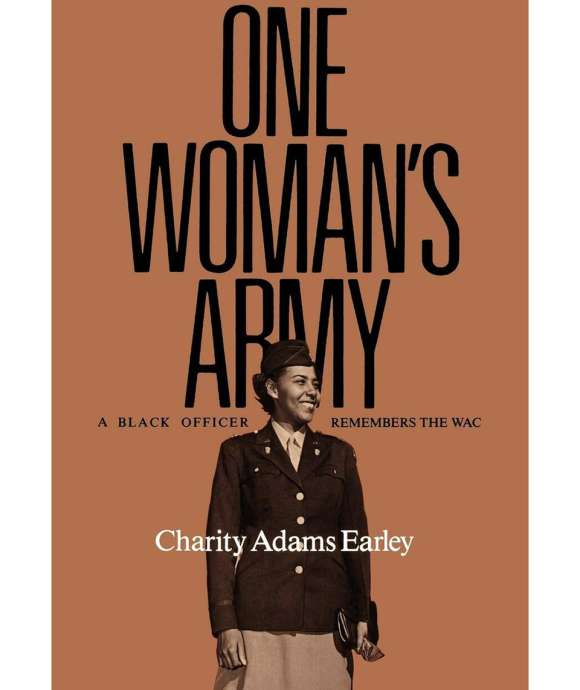
Women in World War II Books
Explore books about Women in World War II in the Museum Store. Proceeds from purchases made through the Museum Store fund the continuing educational mission of The National WWII Museum.
Cite this article:
MLA Citation:
APA Citation:
Chicago Style Citation:
